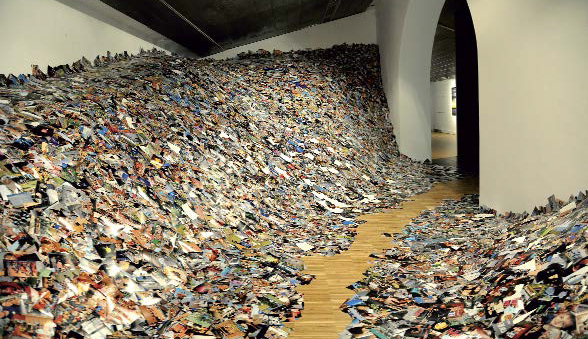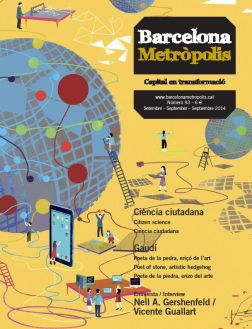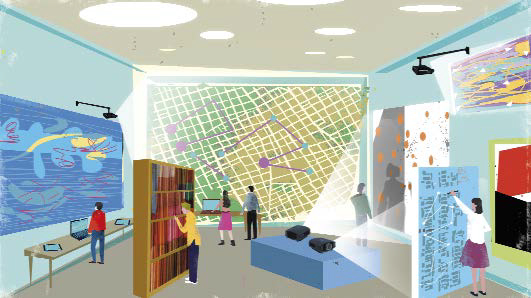Making a city smart through the massive use of technology does not suffice. It requires citizens who are open, participative, enterprising, risk-takers, curious and innovative. The BCNLab project mirrors a path taken by the cities that are pushing the world forward.
We made Barcelona beautiful. We opened it up to the sea, we spread its name across the globe, we turned it into the best shop in the world. Now we have taken on the commitment to make it smart. Having said that, making a city smart by gathering information from sensors in the streets, squares, buildings and traffic lights is not enough. Barcelona wants citizens who are open, participative, enterprising, risk-takers, curious and innovative. It already has smart citizens, but these should now be vitalised and given greater visibility, as occurs in the world’s leading capital cities.
Barcelona’s design and architecture made the international map thanks to the Olympic Games. Later, the Groupe Spéciale Mobile Association acknowledged the city’s innovative potential by making it the host of the Mobile World Congress. And this year, the European Union has awarded Barcelona the title of iCapital for “introducing the use of new technologies to bring the city closer to citizens”.
Industrial restructuring accomplished, the democratisation of knowledge and ICT provides a new backbone for innovation and creativity, which are no longer the exclusive domain of research laboratories and companies. Doing things is now within reach of everyone. Cities are living laboratories where things happen, both in universities and company R&D departments, but also in museums and theatres, libraries, civic centres, government departments, public spaces and in the home. Barcelona Laboratori (BCNLab), a project launched by the new Department of Creativity and Innovation of the Barcelona Culture Institute (ICUB), is a reflection of how cities have begun to drive the world forward. It is an initiative promoted by the City Council to build the city, not to subsidise it. Culture, science, technology, business and citizens walk hand in hand, accompanied by the council. It opens the way for them to be able to implement projects or to reach Europe, but it does not govern their activity.
The understanding between universities and research centres, the business world, citizens and institutions, the so-called quadruple helix, is the way forward for cities. They all need each other in the setting of innovation and creativity in the 21st century.
Culture in the 21st Century
The advent of engineers to culture management has facilitated the deployment of projects such as BCNLab. Video games that are art, scientists who expound results or experiments looking for artistic approaches to reach society, or artists who use technology to express themselves are nothing new. They are expressions totally accepted by modern societies.
For 35 years now, Ars Electronica has been combining art, science and technology in Linz (Austria). In Manchester, FutureEverything has been exploring the possibilities of the Internet from every standpoint for the last 19 years. The Dutch Waag Society, based in Amsterdam, is also working on interactions between software, test tubes and brushes to benefit citizens. And European cities are gradually tapping into institutions and platforms that are helping to break down the barriers between disciplines in order to explore, experiment and provide new solutions to the citizens to which they belong. Barcelona has joined this new culture of innovation.
The Innovation Europe strategy, a Community Directive for the 2014–2020 period, echoes this way of doing things, elevating it to the status of a principle. It calls for a connection between the digital world and the cultural world, and a return to citizens through convergence between fields. And this is BCNLab’s approach: to coax out the creativity and innovation taking place in the city, in every discipline, and make them available to citizens, so that citizens can play an active rather than receptive role in projects.
“It is a very new thing, and as yet there are no rules of play that establish what the creativity ecosystem is,” says Inés Garriga, Director of Creativity and Innovation at the Barcelona Culture Institute, which spearheaded the implementation of BCNLab.

© Antonio Lajusticia
The installation 24 HRs in photos, by Erik Kessels, open at the Centre de Cultura Contemporània de Barcelona until late November 2014. This is an example of artistic representation created using open data information, in this case printed copies of images uploaded to Flickr.
Local and international creativity
In this spirit, BCNLab is forging ahead in two directions at once: listening to local activity and encouraging participation in Europe. Because however clear the way forward may be, there is still no city in the world that perfectly exemplifies the city-laboratory. It is a concept in the making. Barcelona wants to position itself and become a benchmark to be reckoned with, and the competition, with cities such as Copenhagen, London, Stockholm, New York, Manchester, Helsinki and Amsterdam, has set a high standard.
Barcelona has been part of the European Network of Living Labs (ENoLL) since summer 2013. This means that the city has made a commitment, one that has been acknowledged, to promote co-creation (user participation in the design of products and strategies), exploration, experimentation and evaluation of proposals. Through companies, research centres, homes and local government, the city has endorsed this exchange of experience and innovation.
Moreover the Catalan capital is and has been a pioneer in the implementation of European projects in which art and cutting-edge technology have gone hand in hand. This is borne out by Specifi, an initiative that explores the possibilities of the Advanced Internet to support artistic expression. More recently, the CreatiFI proposal has sought to facilitate access by SMEs and creative entrepreneurs to the Internet of the future. The European Union has put up almost five million euros for the creative communities of Catalonia, Brussels, Trento and Helsinki, regions acknowledged as creative hubs on the continent, to explore the possibilities of this combination.
Barcelona’s non-traditional creative companies (scientific research, software and video game companies, electronic publishing) are precisely the sectors that have best withstood the economic crisis. This is highlighted in the report Barcelona Creative Metropolis 2013. The knowledge economy and creative economy in Barcelona, which also indicates that 11% of people in employment in Barcelona work in the creative industries.
Barcelona therefore has actors and resources to promote creativity and innovation. Now is the time for them to reach an understanding and work together for the good of society, and this is where BCNLab comes in. After two years, the platform already includes some twenty innovative projects that seek to nourish public participation; individual initiatives and proposals framed within group activity, as exemplified by the Citizen Science Office, the Musical Technology group and the gaming community.
BCNLab is also present at major city events. The show M.U.R.S. performed by La Fura dels Baus, who opened the Grec performing arts festival, the presentation of the virtual singer Ona during the La Mercè 2013 festivities, and the Festival of Science, Technology and Innovation are a few good examples. Apps&Cultura, a new event aimed at developers, creatives and anyone with an idea for a mobile app associated with the culture of Barcelona, is one of the latest BCNLab initiatives destined to become a classic in the city’s innovation calendar.





excel·lent edició